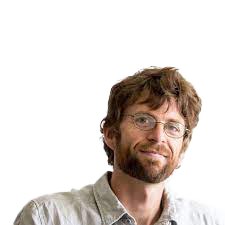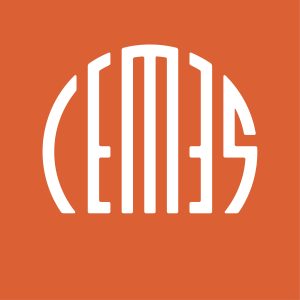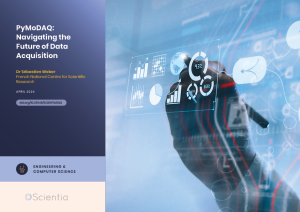Dr Sébastien Weber | PyMoDAQ: Navigating the Future of Data Acquisition
In an era where data is paramount, Dr Sébastien Weber and his team at CNRS, the French National Centre for Scientific Research, are changing the landscape for scientists and engineers with PyMoDAQ, an open-source data acquisition software. Their revolutionary tool stands out for its accessibility, versatility, and the thriving community it fosters.
Bridging the Gap
Data acquisition plays an increasingly pivotal role in the rapidly evolving world of research and technology. It is the backbone of scientific experiments, engineering developments, and technological advancements – and the complexity of reality makes good-quality data a necessity rather than an optional ‘nice-to-have’. The ability to efficiently gather, analyse, and interpret data determines the pace and success of innovation. Dr Sébastien Weber at CNRS, the French National Centre for Scientific Research, worked with his team to develop PyMoDAQ, which effectively bridges the gap between complex data acquisition needs and user-friendly solutions.
PyMoDAQ: An Open-Source Framework
Unlike traditional data acquisition software, which often requires extensive technical knowledge and is typically rigid in its application, PyMoDAQ is designed to be intuitively accessible to a wide range of users. Its modular structure allows for customisation according to the specific needs of various scientific and engineering projects, making it a versatile tool in numerous research and technological fields. In the name ‘PyMoDAQ’, ‘Py’ signifies its foundation in Python, a popular programming language known for its versatility and user-friendliness. ‘MoDAQ’ stands for modular data acquisition.
At its core, PyMoDAQ is an open-source framework that takes care not only of real-time data visualisation and analysis but the entire experimental set-up – ‘experimental orchestration’. The software’s graphical interface simplifies complex data handling processes, enabling users to focus more on their experimental work and less on the intricacies of data management. The offline complex data visualisation with ‘core modules’ can be used as the building blocks for custom analysis software. The data management layout of PyMoDAQ is designed to allow for easy manipulation and use.
An Exciting Graphical User Interface
The graphical user interface (GUI) of PyMoDAQ is designed with the end-user in mind to be intuitive, clear, and easy to use. The interface is clean and well-organised, allowing users to quickly access various features and tools without being overwhelmed by technical complexities.
One of the most exciting aspects of the PyMoDAQ GUI is its real-time data visualisation capability. Users can observe data as it is collected, providing immediate insights and the ability to make on-the-fly adjustments to their experiments or processes. This feature is particularly beneficial in research and engineering environments where real-time data analysis can lead to quicker decision-making and more efficient workflows.
This insight led to the creation of two types of graphical modules in PyMoDAQ, both designed to simplify and streamline the control of experiments. These two modules are named DAQ Move and DAQ Viewer. DAQ Move is responsible for controlling the varying parameters of an experiment, while DAQ Viewer provides visual feedback on the data collected from the detectors.
Importantly, the GUI is highly customisable. Users can arrange and resize panels and controls according to their preferences and requirements, and the GUI also facilitates easy integration with a variety of data acquisition hardware. More importantly, they can configure a given layout for their specific experimental set-up. Users can connect and control different instruments and sensors through its plugin system. The intuitive nature of the GUI means that users can spend less time figuring out how to use the software and more time focusing on their primary research or engineering tasks.
Versatility and Adaptability
PyMoDAQ is fully able to deal with any kind of data, from simple numbers (e.g., temperature), waveforms (e.g., oscilloscope trace), images (e.g., from a camera) or higher dimensionality data (from complex three-dimensional detectors). The underlying data management allows it to consider all these to be ‘PyMoDAQ data’ and allow flexible plotting and saving.
This flexibility is achieved through an extensible architecture. The foundation of this architecture is the GUI, based on the configuration specified by the user. Consider the parameters of the DAQ_Move and Viewer GUI modules. These are both self-generated, constructed according to individual specifications provided. This is critical for the framework to evolve and meet new and emerging needs in the field of data acquisition. The most efficient way to accomplish this is by building new features using a plugin structure that leverages the main components of the framework. This approach enables the introduction of completely new features without the necessity of rewriting the core components of the data acquisition framework, thus maintaining PyMoDAQ’s essence as a modular framework.

PyMoDAQ. Credit Sébastien Weber. The Dashboard allows configuration of the experimental set-up and hosts the Control modules (DAQ_Move and Daq Viewer). Extensions can then orchestrate particular features, such as scanning the varying parameters while grabbing and saving data (in the case of the DAQ Scan) or optimising a given signal as a function of some varying parameters for the Optimisation extension.
Facilitating Research
In PyMoDAQ, the process of data acquisition is seamlessly integrated to facilitate research and experimental procedures. The software features a DAQ Scan module specifically designed for automated and synchronised data acquisition from multiple detectors. This module operates based on the values of one or more actuators, a set-up that enables accurate and efficient data collection across a range of experimental scenarios.
This module automates the selection of detectors and the parameters to be monitored or controlled. In doing so, it ensures that the data collected is not only accurate but also relevant to the specific requirements of the experiment. Additionally, PyMoDAQ includes robust data saving and visualisation mechanisms.
Applications in Imaging and Beyond
PyMoDAQ has already been instrumental in various scientific experiments, particularly in the fields of fluorescence imaging and ultrafast electron microscopy. Perhaps most impressively, the work of Professor Anne L’Huillier, the Physics Nobel Prize winner in 2023, is being continued using PyMoDAQ at Attolab in France.
In fluorescence lifetime imaging, PyMoDAQ is used to control an experimental set-up for measuring the life time of fluorescent particles. The set-up involves triggering electronic excitation in fluorescent emitters using short laser pulses. PyMoDAQ manages the measurement of the arrival times of re-emitted photons using a high temporal resolution photon counter. These measurements reconstruct a binned exponential decay of the fluorescence, allowing scientists to extract the lifetime of the fluorescence of any part of the sample, however small or large. This process is facilitated by PyMoDAQ’s ability to control multiple instruments, including photon counters, microscope cameras, and spectrometers, as well as actuators like XY stages and laser repetition rates.
The FemtoTEM is an ultrafast transmission electron microscope, essentially a pump-probe experiment. It involves exciting a sample with a femtosecond optical pulse (pump pulse) and probing it with a synchronized delayed femtosecond electron pulse (probe pulse). Key elements of these experiments include generating electrons from a metallic nanotip using femtosecond laser pulses and synchronizing these electrons with another optical femtosecond pulse. PyMoDAQ’s role in FemtoTEM is critical for managing various parameters, such as the 3D spatial positioning of the laser focus on the tip, laser intensity, and laser polarization.
What’s Next for PyMoDAQ?
Dr Weber has plans to make PyMoDAQ even more user-friendly and versatile. This involves expanding its library of compatible hardware, thereby enhancing its utility in a wider range of experimental set-ups. The growing PyMoDAQ community, with its increasing number of users and developers, will play a crucial role in this. The contributions of the PyMoDAQ community in developing and sharing plugins will address existing limitations and enable PyMoDAQ to harness a broader range of hardware frameworks.
The future of PyMoDAQ lies in its continued evolution as a flexible, community-driven platform that adapts to the changing needs of the scientific and engineering fields. Its commitment to improving data acquisition processes, expanding hardware compatibility, and fostering a collaborative community sets the stage for PyMoDAQ to remain a key player in research and technology.
SHARE
DOWNLOAD E-BOOK
REFERENCE
https://doi.org/10.33548/SCIENTIA1022
MEET THE RESEARCHER

Dr Sébastien Weber
CEMES-CNRS
Toulouse
France
Dr Sébastien Weber, a prominent physicist and researcher, began his academic journey at Université Toulouse III – Paul Sabatier (UT3), completing his doctorate between 2007 and 2010. His PhD thesis focused on using temporally shaped laser pulses on various atomic systems. From 2010 to 2016, Dr Weber undertook research at several esteemed institutions, including CEA-Saclay (Lydil laboratory), Imperial College London, and CNRS at Université Toulouse III – Paul Sabatier (UT3). Dr Weber is the creator of the PyMoDAQ library, a groundbreaking tool for experimental setup control and data acquisition.
CONTACT
E: sebastien.weber@cemes.fr
X: https://twitter.com/CEMES_CNRS
LinkedIn: linkedin.com/in/sébastien-weber-96a81a8a
KEY COLLABORATORS
David Bresteau and Romain Geneaux (Lidyl laboratory)
FURTHER READING
SJ Weber, PyMoDAQ: An open-source Python-based software for modular data acquisition, The Review of Scientific Instruments, 2021, 92(4), 045104. DOI: https://doi.org/10.1063/5.0032116


REPUBLISH OUR ARTICLES
We encourage all formats of sharing and republishing of our articles. Whether you want to host on your website, publication or blog, we welcome this. Find out more
Creative Commons Licence (CC BY 4.0)
This work is licensed under a Creative Commons Attribution 4.0 International License. 
What does this mean?
Share: You can copy and redistribute the material in any medium or format
Adapt: You can change, and build upon the material for any purpose, even commercially.
Credit: You must give appropriate credit, provide a link to the license, and indicate if changes were made.
SUBSCRIBE NOW
Follow Us
MORE ARTICLES YOU MAY LIKE
Dr Paul Robertson | Artificial Intelligence in the Cockpit: New Systems Could Help Prevent Aviation Accidents
Despite significant advances in aviation safety over recent decades, accidents still occur that could potentially be prevented with better warning systems. Dr Paul Robertson of Dynamic Object Language Labs, Inc. (DOLL) is leading groundbreaking research into how artificial intelligence could help pilots avoid dangerous situations. His team’s work reveals promising developments and important cautions about implementing AI in aircraft cockpits, with implications for the future of aviation safety.
Dr David Nairn | Time-Interleaved Analogue-to-Digital Converters: Breaking Speed Barriers in Digital Signal Processing
In our increasingly digital world, the ability to convert analogue signals into digital data quickly and accurately is crucial for everything from mobile phones to medical devices. Dr David Nairn from the University of Waterloo, Ontario, has been at the forefront of developing and improving time-interleaved analogue-to-digital converter technology to enable faster and more efficient digital signal processing. His work is helping to overcome key challenges in high-speed digital systems, paving the way for more advanced electronic devices.
Dr Michelle Pantoya | More Bang for Your Buck: How Changing the Chemical Properties of Aluminum Particles Increases their Power
Aluminum particles are widely used in various energy generating applications, such as fuels. However, due to their high reactivity with atmospheric oxygen, they must be coated in a chemical ‘shell’ in order to prevent spontaneous combustion. This highly protective shell obstructs oxygen from reaching the aluminum core, limiting aluminum’s potential to produce power. Dr Michelle Pantoya from Texas Tech University has led a research team to explore alternative shell compositions. New shell chemistry has exciting implications for aluminum use in rocket fuels and other propellants.
Revolutionary Battery Technology Promises to Transform Energy Storage
The world of energy storage is on the cusp of a significant breakthrough. As society increasingly shifts towards electrification, from personal devices to transportation and beyond, the limitations of current battery technology have become increasingly apparent. An innovative company in Tallahassee, Florida, is developing a revolutionary new battery that could transform how we store and use energy. The technology, developed by a team of experts at Piersica Inc., promises to deliver an energy density of 630 watt-hours per kilogram (Wh/kg)—approximately two and a half times higher than current lithium-ion batteries. This advancement will extend the range of electric vehicles, enable long-distance electric aircraft, and dramatically increase the battery life of portable electronics.





